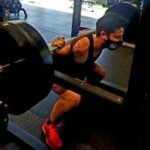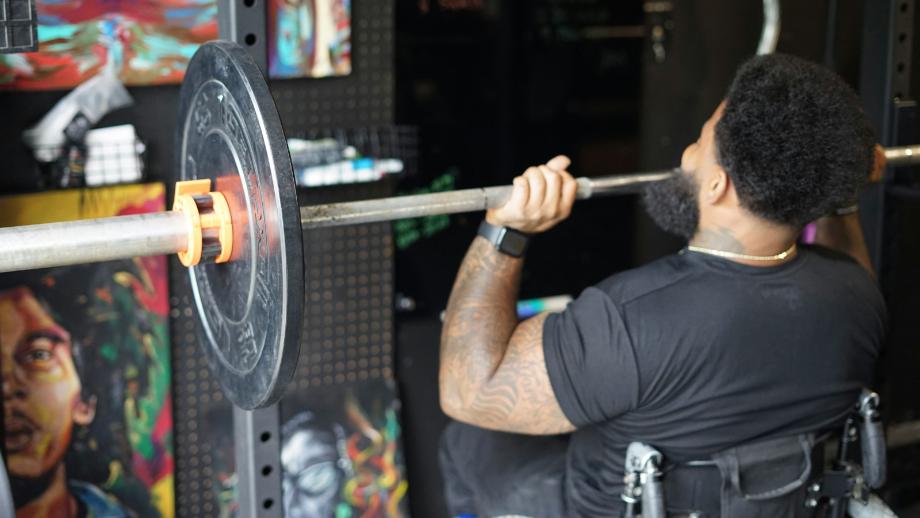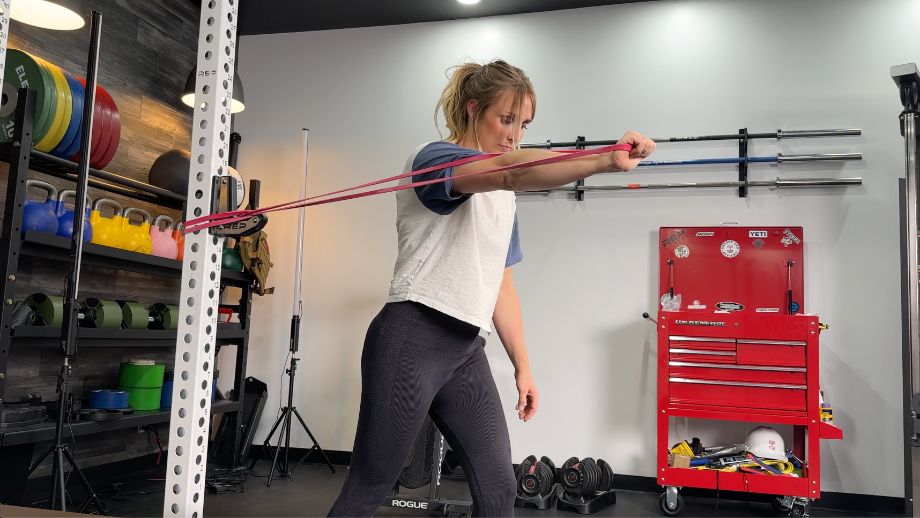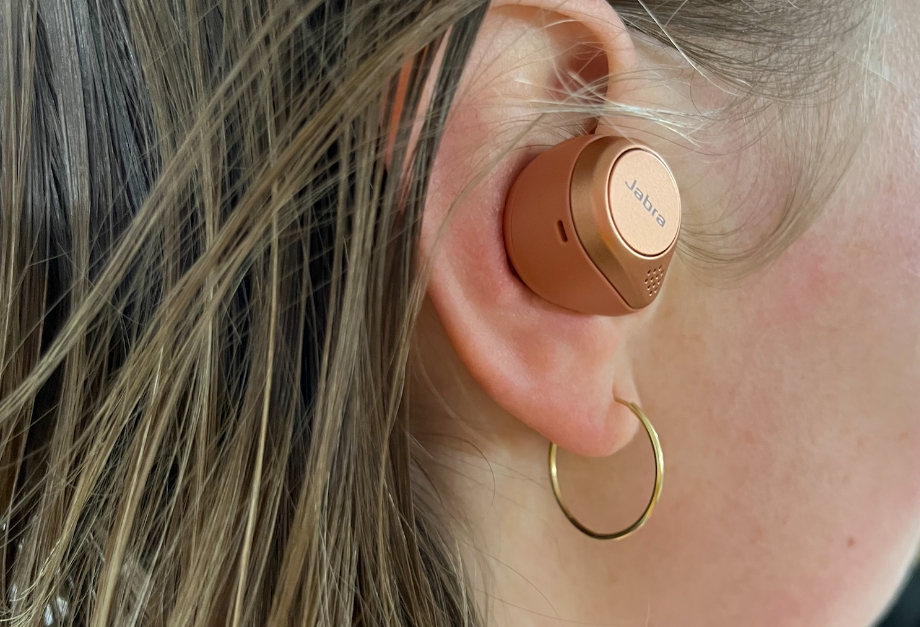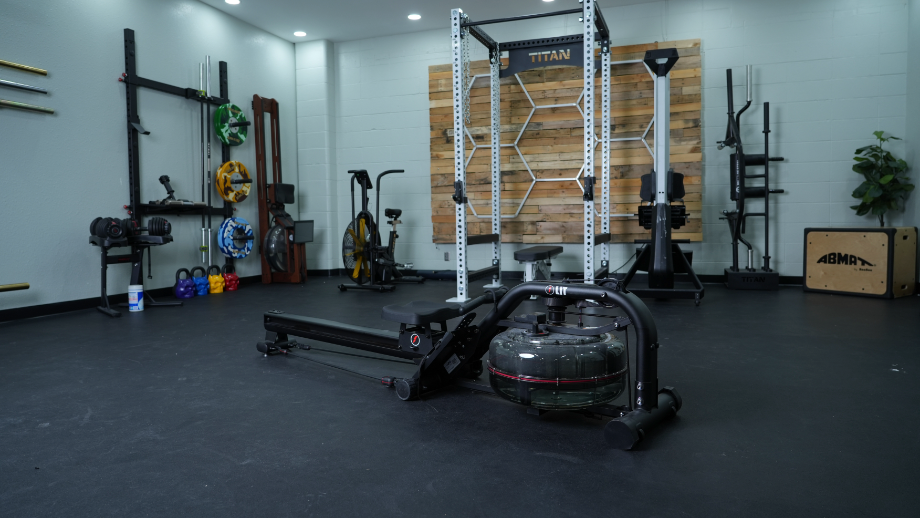The gym is a haven for much-needed physical and mental health boosters for a whole lot of people. It’s where so many take their “me” time, and emerge much happier (and fitter) for it. But for many more people, the gym is a place where you just can’t seem to get through the door—sometimes emotionally, but often physically, as well.
For the one in four adults in the U.S. living with a disability, barriers to safely accessing the gym are often legion. From straight-up physically inaccessible spaces to places that only emphasize banging and clanging without regard to sensory needs, gyms unfortunately often provide far from equitable access.
Here, I’ll break down gym accessibility from a few angles: first and foremost, for people with various disabilities, including one of BarBend’s certified personal trainers and an exercise therapy specialist; gym owners, including one of BarBend’s editorial team members; and gymgoers who aren’t currently living with a disability. As a certified personal trainer myself, I’ll offer tips for customizing exercises for different needs abilities, along with actionable items for all gym owners and gymgoers, to make these spaces welcoming for all so everyone can enjoy the holistic benefits of exercise.
Key Takeaways
- 40% of adults1 with a mobility disability are physically active
- More than 1 in 42 or 61 million adults in the U.S. live with a disability
- Around 5.5 million in the U.S. use a wheelchair3
- Active spaces like gyms and health clubs should be inclusive and friendly to support the health and well-being of people with disabilities, people who are neurodivergent, and people with limited mobility.
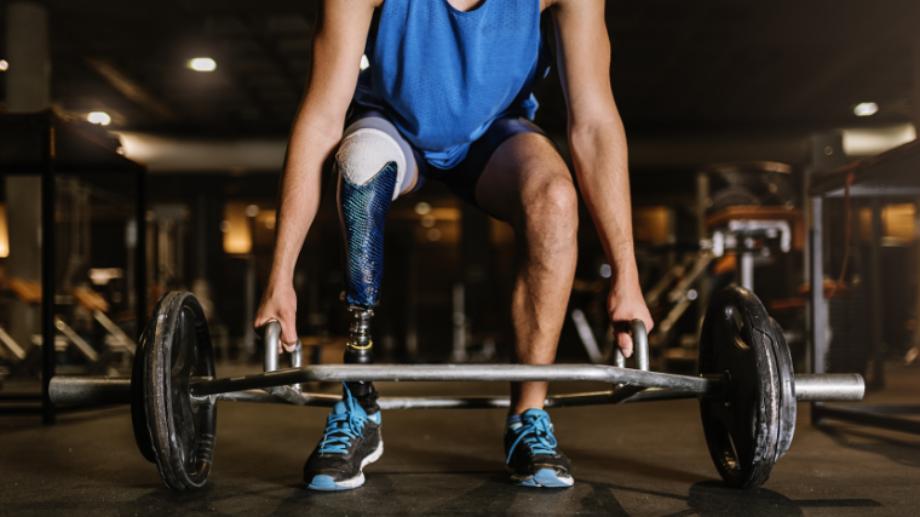
Barriers to Access in Fitness Spaces
Let’s be real — no one (not even the beefiest among us) is immune to gymtimidation or feeling out of place in the gym. But there are undeniably structural barriers in place that prevent many people from marginalized backgrounds and experiences from accessing fitness spaces like gyms. Because of this, people with disabilities often face a unique set of barriers that people without disabilities do not experience.
Of course, people with disabilities are a diverse group; there are many different types of disabilities, all of which interact with every other part of a person’s life and identities (think: race, gender, sexuality, class, etc.). Even within each group, not every person will face every barrier. Still, there are some commonalities we can trace.
A 2021 scoping review4 of studies summarizes the reported barriers that folks with disabilities express when it comes to gyms. The review breaks the barriers into three categories: physical, environmental, and social.
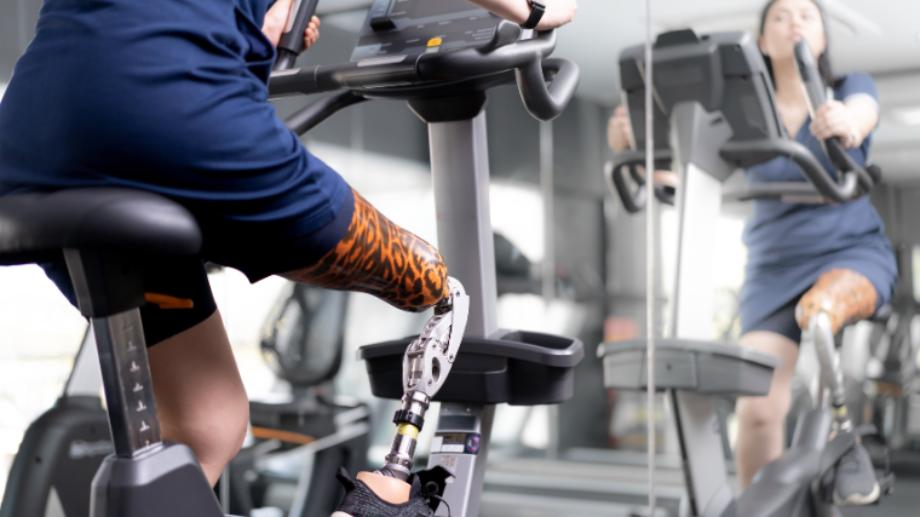
The review notes that physical barriers are often the first and only barrier. If someone cannot get into the building, they do not have further experience with gyms, and are therefore completely blocked from accessing any other feature or potential benefit.
Social barriers may also arise due to the stigma, defined as a “negative set of beliefs” against people with disabilities. People who experience disability stigma may internalize it or purposely avoid social interaction.
Stigma doesn’t have to include active, cruel beliefs. A stigma-based belief can also simply include: “People with disabilities can’t or don’t want to exercise” (which is untrue). You might not be conscious that you hold this stigma until you realize that you’re surprised when you see extremely fit athletes with disabilities performing very well.
Stigma leads to what the review called “direct and indirect psycho-emotional disablism5.”4 Direct disablism describes a negative interaction with other people. Indirect disablism arises after encountering physical barriers, which may make a person with disabilities feel excluded and discriminated against.
It’s important to note that social barriers (like stigma) can create additional environmental barriers. If a gym owner unconsciously believes that people with disabilities cannot or don’t want to work out, they might think they don’t need to design their space to be accessible with things like quiet workout hours, spaces for wheelchair use, and training their coaches to know how to customize workouts for people with various disabilities.
Here are some examples of how these barriers can manifest themselves in fitness spaces:
- Physical Barriers:
- Lack of transportation to the gym
- Not enough wide spaces for wheelchair access
- Challenging to grab door handles
- Protruding objects
- Non-adjustable exercise equipment
- Environmental Barriers:
- Inconvenient scheduling
- Not knowing where or when to exercise
- High cost of membership
- Use of small fonts throughout the facility
- Denying accommodations for people with disabilities
- Inadequate standards and policies
- Social Barriers:
- Fitness instructors and personal trainers who lack the skills to adapt exercises or adjust to the needs of people with chronic pain or illness
- Lack of group classes that can be modified to their abilities
- Lack of social support
- Fear of asking for assistance
- Lack of inclusivity in gym set-up and class structures
- Fear of being stereotyped or discriminated against
- Negative attitudes from staff and negative interactions with others
- Negative feelings: feeling like a burden, feeling othered, loss of autonomy
You’ll notice that many of these personal barriers — “fear of asking for assistance” — are directly informed by structural barriers — “lack of inclusivity in gym set-up and class structures.” If gyms don’t proactively address issues of accessibility by stating that they are committed to providing accessible spaces, it will only reinforce a person’s fear that they won’t be accommodated or will be scoffed at. By proactively designing gym spaces to fit the widest ranges of abilities, gyms signal to people with disabilities that it’s safe to advocate for what is needed.
Alex Polish is a certified personal trainer and BarBend editorial team member who lives with various disabilities and chronic pain. They explain: “If I go to a yoga class, for example, and the instructor doesn’t start by saying something like ‘Everyone’s practice looks different, and you can always return to positions that feel comfortable for you’ or ‘Don’t force yourself into poses that hurt,’ then I feel like they’ll judge me if I have to take a rest or if my poses don’t ‘look right.’ Or maybe they don’t know how to help me with modifications that I need. So I’m less likely to ask, and more likely to push through pain and panic to avoid feeling shamed. It’s a ‘me’ problem, sure — I want to be able to advocate for myself in any situation — but still, fitness is a lot more accessible when instructors and gyms state that they value accessibility for everyone. At least I know they’re thinking about it and are open to helping out.”
Kate Meier — also a certified personal trainer and BarBend editorial team member, as well as a former co-owner of a CrossFit gym and current owner of a small weightlifting gym — says that if you experience gym anxiety, you’re not alone.
“Entering a gym can be scary for anyone. I’ve seen social anxiety, concerns over not knowing what to do with a barbell, physical limitations, child care concerns, all of it. No matter what someone’s circumstances are, I want to find a way to ensure they get a good workout. It starts with a conversation.”
Here’s some knowledge for you to enter your conversations with, whether you’re a gymgoer or potential gymgoer with a disability, a gym owner, personal trainer, or even a gymgoer who doesn’t currently have a disability who’s interested in doing your part to create a welcoming, accessible fitness community.
Tips and Exercise Modifications for Gymgoers With Disabilities
An important note: many people, including those with chronic illness or chronic pain, may not need to consistently modify all exercises. Someone may well be able to do a traditional set of box jumps one day, and need to switch to step-ups only — or even just regular walking — during the next training session.
Frieda Johnson, a specialist in exercise therapy who also has a disability, explains the common misconceptions about physical disabilities.
“So many people without disabilities are shocked to learn that the majority of people who use wheelchairs can stand or walk. It’s actually a very small percentage of wheelchair users who can’t. There are many reasons why people need to use a wheelchair or other mobility device sometimes and not others, or why they need them in some situations and not others. I myself use a cane, and on rare occasions a wheelchair, but only when I will be walking long distances or am having a pain flare-up. I have a genetic muscle disease, so some days I can walk for miles with no problem, and some days my muscles literally don’t have the strength to support me. I also have muscle and joint pain that changes a lot based on the amount of inflammation on any given day, which also affects what I can do and whether I need a mobility aid.”
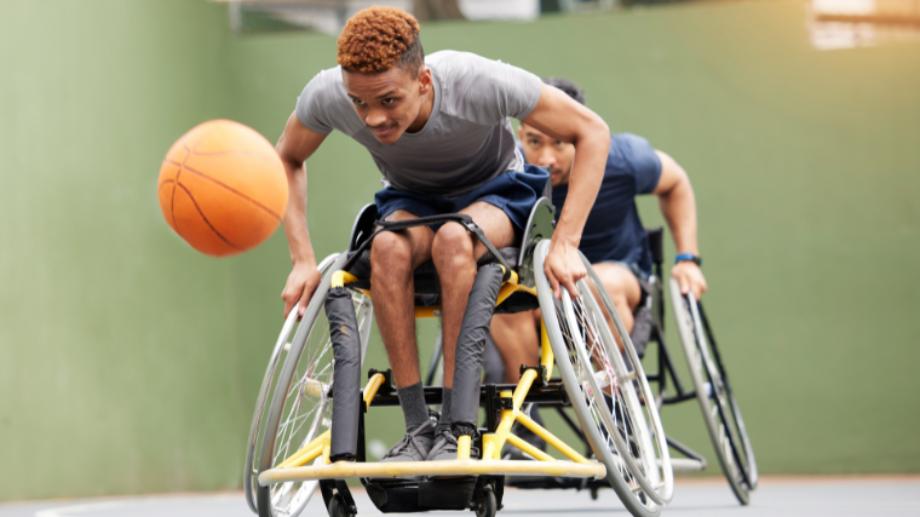
Whether you’re someone’s training buddy, a coach, or an athlete yourself, it’s critical to know that having fluctuating abilities is more than OK, it’s completely normal.
Polish explains that personal trainers and group fitness instructors might just not know the vast range of movement patterns and modifications that are possible for gymgoers with disabilities. “Most personal trainers are taught that there are certain ‘right’ ways to do movements. But as someone with chronic pain, I know that my form often looks ‘wrong.’ It’s not fair when the burden of educating everyone falls on us, but it can be helpful to do some research before working with a trainer — especially if you don’t have access to a trainer who has experience working with an actually diverse population — so you’ll feel more confident saying ‘I need to do this exercise this way.’”
Exercises do not have to look only one way in order to “count.” Just because you can do an exercise with a certain form on one day does not mean it’s less “good” if you need to customize it another day.
The CDC recommends that people with disabilities get 30 to 40 minutes of moderate-intensity exercise or 20 minutes of vigorous-intensity exercise every day. While this recommendation is certainly reachable for many, it’s important to note that there can be tremendous barriers to access: does someone have a safe, affirming place to get said exercise?
Since exercise is traditionally portrayed as the purview of apparently non-disabled athletes, people with disabilities rarely (if ever) can see themselves represented in fitness spaces. This lack of representation can dramatically decrease a potential exerciser’s sense of safety, community, and know-how.
Because of this, along with various stigmas about disabilities, another barrier that many people with disabilities may face is a lack of knowledge about exercise6 — how to exercise, how to modify for limitations, fear of feeling pain, and not knowing what is safe.
An athlete performs a deadlift on a yoga mat using an assistive device. Credit: Yurakrasil / Shutterstock
For coaches and potential athletes alike, no need to panic about all these barriers — just like learning to coach or perform a biceps curl, learning to customize exercises is a skill you can develop (hence, you reading this article).
For example, as a certified personal trainer who teaches exercise for seniors, I have learned to modify and customize exercises so that older adults can continue increasing their strength, mobility, and aerobic fitness in a safe, affirming, and challenging environment.
Of course, not all older adults have discrete disabilities, but I’ve trained many who do. It’s all about finding ways to meet anyone where they are, helping them get stronger in whatever way possible, and making specific modifications for each individual. Listening to each person about what feels best for their body is important for every single client, and that doesn’t change when you’re working with gymgoers with disabilities.
For gymgoers themselves, that means that while personal trainers may have general expertise about exercise, you are still the expert about your body: keep an open mind about what you’re capable of (you might surprise yourself), but don’t be afraid to advocate for yourself.
Gym Modifications for Unique Needs
For each of the following types of disabilities, I’ll give tips on what exercises work well and how to modify workouts to make them more accessible.
And Kate Meier, certified personal trainer and gym owner, adds that it’s not terribly difficult to ensure that even your group classes include customized movements:
“Even in group class settings, you can personalize a workout. In fact, workouts should always be personalized. Not everyone can squat below parallel, and some people can hold weight and some people can’t. And some people can do full push-ups and some people need to modify. It’s about giving people options! In a group class, there should always be several options for a movement.”
Workout Modifications for Wheelchair Users
Wheelchair users can do many of the best arm exercises just like people who don’t use wheelchairs. People who use wheelchairs, in particular, can benefit from strengthening their upper body muscles to support using their mobility aid. You may also find yourself able to do several leg exercises, depending on your specific needs. Plenty of powerful CrossFitters, for example, are wheelchair users.
Want to learn more? Check out the Adaptive Training Academy (ATA) and peruse their free resources (or consider getting certified). When you open their website, you can enter your email and phone number to receive a free lesson on the types of wheelchairs that adaptive athletes use (hint: the hospital-style wheelchairs often featured in stock images don’t cut it and just aren’t used in the weight room).
Safety Tips for Using a Wheelchair in the Gym:
- Always ensure the wheelchair is stable.
- Put the brakes on when doing seated exercises.
- Have a trainer or buddy hold down the front of the wheelchair to prevent it from tipping.
- Place a step or box behind each back wheel.
Wheelchair-Friendly Gym Exercises
Of course, as an athlete or potential athlete who uses a wheelchair, you know your body best. But here are some general lifts that might work for you.
Dumbbell Arm Exercises:
- Seated Chest Press
- Seated Dumbbell Row
- Shoulder Press
- Lateral Raises
- Front Shoulder Raises
- Upright Row
- Biceps Curls
- Hammer Curls
- Wrist Curls and Wrist Extensions
- Overhead Triceps Extensions
Cable Arm Exercises:
You can attach different handles to a cable machine, adjust it to the proper height, and do any of the following exercises.
- Seated Row + Single Arm Row
- Lat Pulldown + Single Arm Pulldown
- Chest Press
- Palloff Press
- Chops and Lifts
- Rope Triceps Pushdown
- Face Pull
Other Equipment:
- Landmine Rotation
- Landmine Press
- Battle Ropes
- Medicine Ball Slams
- Medicine Ball Chest Pass or Overhead Toss
- Resistance Band Exercises
Leg Exercises:
People who can use their legs may be able to do some of the following exercises. Some gyms may have machines with removable seats so you can pull your wheelchair up. Some folks may also be able to sit on a machine with or without assistance.
- Leg Extension
- Leg Curl
- Hip Abduction and Adduction
- Seated Calf Raise
- Straight Leg Raises
- Seated March
Cardio Exercises:
- Hand Crank/Arm Bike
- Ski Erg (you can use arms only)
- Rower (some gyms have an arms-only rower)
- Wheelchair Sprints
- Aquatic Exercise
- Seated Sports (e.g., basketball or tennis)
- Mini Bike (folks who can pedal but can’t sit on a bike can check out the best mini exercise bikes to do from a seated position.)
How to Modify Common Workouts for Wheelchair Users:
- Strength Workouts:
- Superset Modification: Instead of doing an upper body exercise and one lower body exercise (if you’re unable to do a lower body exercise), pair two upper body exercises that use agonist and antagonist muscle groups.
- Examples: Chest Press + Row or Biceps Curls + Triceps Extensions.
- If you can do lower body exercises, bring your dumbbells over to a leg machine.
- Examples: Leg Extensions + Shoulder Press or Leg Curls + Upright Rows.
- Superset Modification: Instead of doing an upper body exercise and one lower body exercise (if you’re unable to do a lower body exercise), pair two upper body exercises that use agonist and antagonist muscle groups.
Cardio Workouts:
You can incorporate wheelchair-friendly exercises into common cardio workouts, which may be steady-state (performing a moderate-intensity exercise for 30 minutes or more), HIIT (high-intensity interval training), or interval workouts.
- Examples:
- Steady State: 20 minutes on the hand bike or 20 minutes wheeling
- HIIT or Intervals: 20 seconds wheelchair sprint, 20 seconds medicine ball slams, one minute rest
Workout Modifications for People With Arm or Leg Weakness or Instability
For arm or leg weakness or instability — including flare-ups of chronic pain — unilateral training and isometric exercises7 can be helpful. Working on one side at a time strengthens the side you’re using, and the less- or non-working side does as well — based on the idea of cross-education. If you’re unable to do as much with your left arm, for example, training your right arm can still strengthen your left.
Isometric exercises also help as engaging your muscles and holding in one position allows you to build strength without loading any excess weight.
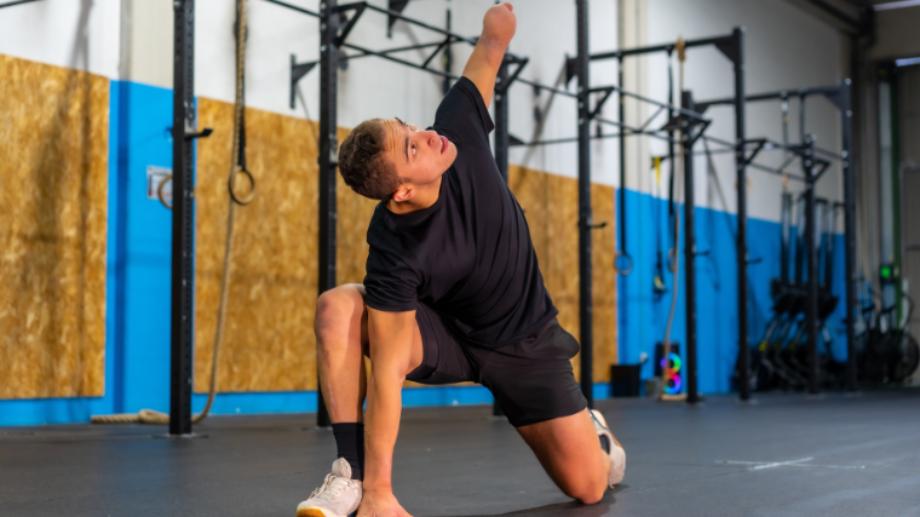
Want specific, high-intensity workouts that are programmed for athletes with disabilities similar to yours? WheelWOD — a CrossFit-focused organization — offers specific WODs (workout of the day), programs, and competitions for wheelchair users.
Arm Weakness or Instability:
- Unilateral Arm Work8: Single-Arm: Row, Chest Press, Pulldown, Shoulder Press, Lateral Raise, Shoulder Raise; Single-Arm Pull-Up
- Isometric Arm Work: Plank (or elevated plank) or hold the top position of the above
Leg Weakness or Instability:
- Unilateral Leg Work8: Single-Leg: Extension, Curl, Press, Abduction, Adduction, Leg Raise and Calf raise; Single-Leg Box Squat
- Isometric Leg Work9: Wall Sit (modify for wheelchair users: squeeze your glutes and abs and irradiate maximum tension while staying seated); hold the top position of the above; or thigh presses (pressing your legs together as much as possible)
- Sit to Stand10: Practice going from sitting in a chair to standing up — one of the best leg exercises you can do if you’re trying to gain some strength as a newer wheelchair user. You may also be able to do TRX-assisted squats.
Workout Modifications for People With Seizures and/or Muscle Weakness
For many athletes, seizures may be a relatively common life occurrence. If you’re a gym owner, educating yourself and your staff is key — checking in with your members about their needs and preferences is critical. For example, for most people with seizure disorders, a seizure is not a medical emergency that requires calling an ambulance.
If you’re someone who is prone to having seizures or experience muscle weakness that may make exercise a bit more dangerous for you, it’s important to let staff members know what they can expect and how to help you out on your own terms.
Here are some tips for increasing your levels of safety on the gym floor:
- Always have a spotter who is aware of your condition and knows what to do in case you need assistance.
- Consider doing primarily calisthenics or floor-based exercises to reduce your likelihood of injury if a seizure or flare-up occurs. Ask a personal trainer or group fitness instructor, as relevant, which bodyweight exercises can substitute for which weighted movements.
- Have a plan to minimize injury risk in the event of a seizure or flare-up of muscle weakness happens, and share that plan with gym staff.
Static Bodyweight Workouts for People With Joint Pain
If you have joint pain, you may understandably not want to bend your joints or put them under all that much pressure. In some cases, strengthening the muscles around the painful joint11 can help, so you don’t necessarily need to swear off squats to work around knee discomfort, for example.
It’s also OK — and necessary — to ease off on days with significant pain flare-ups. You can do isometric exercises to strengthen your muscles while keeping your joints static. Here are some isometric alternatives for three main bodyweight exercises.
- Squats: Wall Sit (or in a chair)
- Push-Ups: Straight-Arm Plank
- Pull-Ups: Static Hang
Tips for Neurodivergent Gymgoers
Neurodiversity12 generally refers to the variety of ways that brains can and do develop. Neurodivergent people may include folks who are autistic or have ADHD (attention-deficit hyperactivity disorder), dyslexia, OCD (obsessive-compulsive disorder), or other neurodivergences. As with all language and identities, the definition and language surrounding it is still evolving.
Neurodivergent people may have different processing styles than the ones typically accommodated for in school, work, and other social systems. They may have heightened sensitivity to sensory input that causes anxiety and challenges with executive function, body awareness (interoception and proprioception), focus, and attention. They may also face challenges with social interaction.
While not always related to neurodevelopment, experiencing trauma changes the structure of your brain, and may cause a disconnect between mind and body. Research shows13 weightlifting can be a helpful tool for managing symptoms of PTSD, improving self-efficacy and self-identity, and providing social connection. Instructors can take trauma-informed weightlifting training14 to help design safe spaces and adaptively coach folks with trauma.
“As someone who’s neurodivergent, what I need at the gym definitely varies from day to day,” explains Alex Polish, a certified personal trainer and BarBend editorial team member. “Some days — especially if I’m going during a time I’m unfamiliar with — I need my wife to walk with me to the gym. And that’s saying something, because the gym is my happy place. And yet, I still need help going and navigating. Sometimes, I need to blast my own music in my headphones; other days, everything is way too loud and scary for me (that’s my trauma interacting with my neurodivergence); and still other times, the sound of weights clanging over loud music is exactly what I want and need. That’s all OK — that’s the kind of flexibility we need to afford ourselves and that we deserve for gyms to afford us.”
Here are some gym tips and recommendations that may make navigation easier.
- If you’re routine-oriented, keep a structured schedule for when you go to the gym. This can potentially ensure that the gym environment is consistent in terms of who is there, how many people are there, the lighting, and the noise level.
- If you have challenges with executive functioning, setting specific, achievable goals15 that you can chip away at in small increments may help. You also may need to be flexible to allow for days that your brain isn’t up to it. You can always modify workouts to increase strength without sticking to a rigid plan.
- For people who struggle with focus, varying your workout routine and quickly changing your activity, like in circuit training, may stimulate your brain for longer15.
- Stay in tune with your specific needs and preferences. If you have sensory sensitivities, you may prefer a quieter yoga class to a crowded gym workout at prime time.
- Build a support system, so you have someone to rely on. Finding a trainer or gym buddy knowledgeable about neurodiversity can help you learn in ways that work best for you15.
- Pack your headphones for music and also noise-canceling earbuds if everything gets too overstimulating. Some folks may also use a nasal numbing agent if they’re very sensitive to smells (which isn’t just about BO — many people are often sensitive to smells others consider pleasant, like scented bathroom or shower soaps, powerful body spray, and even scented cleaners many gyms use for wiping equipment down).
Social Challenges in a Gym Setting
While modifying workouts and using exercise alternatives may help ease the physical part of a workout, the social component of going to the gym is still difficult for everybody, regardless of ability.
People without disabilities may still experience barriers to inclusion at the gym if they don’t fit a narrow and specific set of body types. People of marginalized races, genders, and sexualities may also be excluded implicitly and explicitly. And for people with disabilities who experience these other types of marginalizations, exclusion at the gym (and elsewhere) can take on entirely new and difficult dimensions.
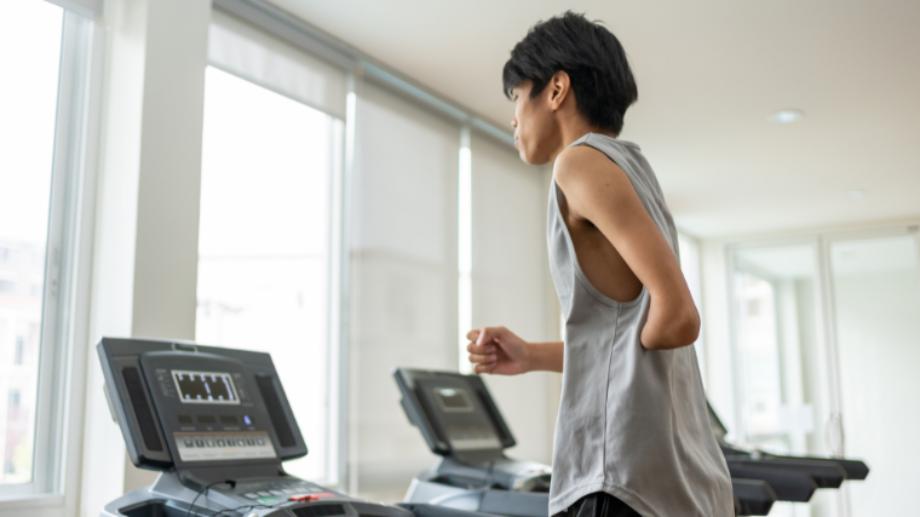
Finding social support in a gym can be helpful for anyone. Once you see that most people are there to focus on their workout and (usually) not to judge others, it may help you feel more comfortable — of course, this doesn’t take away from the stigma that still exists.
Here are some tips for finding social support as a gymgoer with disabilities:
- Find a workout buddy with whom you can set strict boundaries. This way, you’ll have social support but still be “in the zone” at the gym.
- Before joining a gym, research reviews online to assess the social elements. Places like Reddit often have folks discussing gym environments with a whole lot of honesty.
- Working with a personal trainer (if you can afford it) provides more than workout support; it also offers social support. Working with a trainer who is competent in training people with your specific set of experiences and needs can help you feel empowered as you learn specific skills to reach your fitness goals. You also have a safe person to interact with, and help you feel more comfortable at the gym.
Service Animals at the Gym
A service animal is typically a dog trained to help a person with disabilities. According to the Americans with Disabilities Act (ADA), service animals are allowed16 in any business where people can go. Individuals are legally entitled to have them in any gym or fitness facility.
People with different disabilities may have service animals for various reasons. Here are some tips and examples of bringing your service animal to the gym.
- For neurodivergent individuals:
- Have your service animal lay next to you during a yoga class or accompany you to different areas of the gym. If your service animal is registered as an emotional support animal, your gym may not be required to grant access, as ESAs are not technically service animals. Still, many gyms have very open policies about welcoming dogs of all kinds into the environment. Call ahead and inquire if you can, or check reviews online.
- For people with visual impairments:
- For cardio exercise: There may be bump dots on cardio machines so you know which buttons to press, after having your service animal guide you to the right area.
- For strength exercise: If you need an assistant to help guide you, as a service animal may not be able to, some gyms offer them a discounted membership.
- Choose a slower time of day at the gym when it is less crowded as you learn to navigate the space with your service animal.
Know Your Rights
While navigating the gym with disabilities can come with challenges when they’re primarily designed for people who don’t have disabilities, you have rights that you are legally entitled to, and actions you can take if they are violated. Here’s what to know.
Legal Rights:
- The ADA17 is a federal civil rights law that states that people with disabilities need to have the same opportunities as everyone else.
- The ADA prohibits discrimination by businesses against people with disabilities.
- Businesses and facilities open to the public (like gyms) must follow ADA requirements and provide “equal opportunity to access the goods or services they offer.”
- People with service animals have the right to bring them to the gym. The ADA states that businesses must modify their rules to accommodate service animals, like an exception to a “no animals allowed” policy16.
If your rights have been violated, you have a right to assert them and advocate for yourself, and the ADA prohibits retaliation against anyone who does so. You can file an ADA complaint with the Department of Justice Civil Rights Department against a private business, online or by mail, by visiting their website. They will review your complaint18 and get back to you within three months.
Tips for Gym Owners and Staff on Creating More Accessible Environments
Yes, people with disabilities unfortunately have to advocate for themselves a great deal because services and equitable access are often not provided proactively. But ideally, it should not be the burden of people with disabilities to ask for accommodations. Instead, people who own and work at gyms must take steps to make these environments accessible and inclusive.
Kate Meier — a certified personal trainer, former co-owner of a CrossFit gym, current owner of a small weightlifting gym, and BarBend editorial team member — says that it’s the core responsibility of gym owners to do everything in their power to provide equitable access to fitness. “As a gym owner, my priority is to make sure that the people who come to my facility are able to meet their goals.” Here are some of the ways you can accomplish this.
Creating an Accessible Space
As a business owner, you must comply with ADA legal requirements to make your gym physically accessible. Legal compliance should be the bare minimum — you will need to go above and beyond to make it actually be inclusive.
ADA Compliance
Here are some ADA compliance laws19 to consider for your gym.
- Accessible Parking: Create designated and accessible parking spaces close to the entrance. Cut the curb so a wheelchair can access the sidewalk, and install a ramp as an alternative to stairs. These accommodations also help people with visual impairments.
- Wide Doors: Doors must be wide enough for wheelchair access — at least 36 inches.
- Floorspace for Wheelchair Access: Once a wheelchair can pass the front door, think about creating enough floor space in the actual workout areas.
- Low Counters: The counters at any desk (reception, juice bar) should be low enough for a wheelchair user to reach them. You should also have lower water fountain options.
- Restroom Access: Provide large, low toilet seats, larger restrooms, grab bars, and a bench in shower stalls.
- Pools20: Pools must have accessible entrances, such as a motorized chair that lowers someone into the water as an alternative to climbing down a ladder or a wet ramp. Pool decks must also be clear and uncrowded.
- Saunas and Steam Rooms: Must have wide doors and low seating options.
- Visual and Audio: Use visual alarms for Deaf people and create signs around equipment, with raised bump dots when possible. Not all people with visual impairments can read Braille.
Beyond ADA: Creating an Inclusive Environment in Your Facility
Take things a step past the minimum legal requirements for a private business20. Kate Meier, weightlifting gym owner and certified personal trainer, says it’s absolutely essential to do more than the ADA requires.
“Basic ADA compliance for a fitness center is pretty bare-bones…[It] really doesn’t do much to accommodate people with disabilities other than say, ‘Hey, you can get into the building.’”
As fitness pros, it’s our responsibility to do better. “As a fitness professional, my goal is to make exercise accessible to anyone who approaches me for help,” Meier explains. “I don’t believe people should be ‘priced out’ of exercise. It’s a hard line to walk because personal trainers still need to make a living, and we need to know our worth. But it would break my heart to know someone wants to exercise and just needs a little direction without going broke. So at my gym, we meet people where they are. We provide different plans, flexible payment options, and remote coaching.”
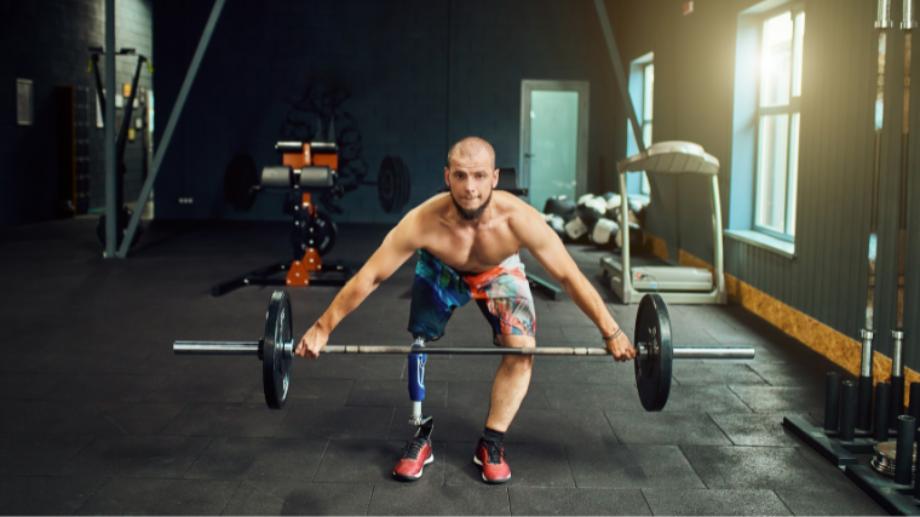
Meier also works to ensure that her gym’s hours are flexible for all members. “The gym I currently own is essentially open around the clock because we have some people who can only exercise in the early morning, and some people who can only come late. We do have structured classes and set team practices for the weightlifting team, but we’ve never told someone they can’t come work out at a given time. If they want to exercise in our space, they get to exercise in our space.”
Going beyond ADA compliance also means having some specialty equipment available whenever possible. Meier explains: “I make sure we have the tools for people of all physical abilities to get in a workout. On top of basic equipment, we have specialty equipment like safety squat bars for those with an upper body injury/issue. We have MonkeyFeet and hand weights of all sizes for those who need to do seated movements. And we can improvise because we have decades of experience working in the space.”
Here are some ways you can set up your gym — and your policies — to ensure that your services are as accessible as possible.
Universal Design Elements:
- Stock your gym with specialty equipment like safety squat bars, MonkeyFeet, and different sizes of hand weights.
- Provide flexible payment options, remote coaching opportunities, and different membership plans.
- Offer flexible, broad-ranging hours to accommodate many different schedules, abilities, and fluctuating pain levels for gymgoers with chronic illness or chronic pain.
- Remove environmental barriers around equipment, and add extra space around each row.
- Automatic opening doors.
- Purchase specific equipment for folks with disabilities; examples include21:
- Lighter weights
- Hand crank or an arm bike, arms-only rower
- Weight machines with swing-away seats
- Include raised, cushioned tables for folks who can’t stretch on the floor
- Harbinger lifting and hauling hooks for gripping aid
- Adaptive jump ropes
- Have more than one accessible bathroom or changing room. Include handrails for left-handed and right-handed people.
- Include lockers of different heights.
- Offer a free trial visit period.
- Use large, clear, readable print in signage, and have an audio alternative.
- Have a TTY phone for emergencies.
- Include chairs in group fitness studios.
- Pools should have a different texture on the floor close to the pool entrance so that people with visual impairments know when they are approaching the water.
- Offer “quiet workout hours,” listed publicly on your website, so people with sensory processing needs can know which periods of time the music will be lower or off and the clanging will be softer.
- Offer unscented bathroom soaps and equipment sprays with minimal chemicals.
Inclusive Communication Best Practices
According to weightlifting gym owner and certified personal trainer Kate Meier, it’s critical to make sure staff members are prepared to work with many different populations.
“The people who work at my gym are fluent in knowing how to modify movements, provide alternatives, and otherwise ensure that everyone who comes into the space can exercise.”
Kate Meier, Weightlifting Gym Owner
Humility is another big key here, Meier explains. You’ll need to approach all clients and potential clients with openness, curiosity, and as an individual who can benefit from your exercise expertise, but is the expert on their own body. “I won’t pretend like I always have an answer,” Meier explains. “The first time a person who uses a wheelchair came into one of my classes, I’ll admit I was a little nervous. But I spoke with the person, and together we came up with movements that were modifications of what everyone else was doing so that person could participate and enjoy the class.”
This also means communicating openly and honestly, commiting to learning and improving your practice at all turns. “When I was part owner of a CrossFit gym, we had nearly 200 members. Our coaches would meet every week to talk about any issues any of our members were having so everyone had total visibility. If someone had an injury or disability, we would talk through solutions, modifications, offerings. We would meet with our members individually and create a space where they could share with us concerns or questions.”
Once you have made the effort to have everything physically in place, you’ll need to implement best practices for inclusive communication. This includes training staff and communicating with members. These ideas are not legally required but help you go above and beyond to make the space welcoming.
- Offer opportunities for all your employees to get trained in best practices for working with a diverse array of people.
- Offer opportunities for your employees to become ATA-certified, trauma-informed weightlifting certified, or a similar certification.
- Indicate prominently on your website or Instagram that you are dedicated to providing a safe, inclusive workout experience for people of all experience levels and abilities (just be sure you’re prepared to follow through on that commitment).
- Offer an anonymous feedback form for gymgoers or potential gymgoers who have questions or suggestions about accessibility concerns.
- Offer discounted or free membership if someone with disabilities needs to bring an assistant.
- To take the burden off people with disabilities, have someone available to advocate for these individuals, answer questions, or provide instructions.
- Train all staff to assist people with disabilities.
- Seek, hire, and support personal trainers and group fitness instructors with professional skills, knowledge, or certifications in training people with disabilities.
- Offer group fitness classes at different levels and for people of various abilities.
- Instructions for machines should be printed in a large font and include Braille or raised bump dots.
Social Accessibility: Creating an Accessible Environment for Neurodivergent People
It’s not all about physical access — sometimes it’s about emotional and psychological access to calmer, affirming spaces.
“Sure, I usually love the sound of iron on iron in the gym,” explains Alex Polish, certified personal trainer and BarBend editorial team member. “But when a gym offers any options like quiet workout times and have clearly articulated community guidelines, I automatically feel safer in the space — and then, I can lift a whole lot heavier and safer.”
- Loud Music: When possible, avoid playing the radio, as commercials can get loud and radio hosts’ commentary can be jarring and distracting. Many gyms keep the volume extremely high; consider lowering it to a medium level to accommodate sensory-sensitive folks.
- Dimmer Lights: If possible, avoid extremely bright, fluorescent lighting.
- Temperature Control: Place a sign under any thermostat stating that individuals are welcome to ask staff to request a temperature change.
- Unscented Atmosphere: In a gym, the instinct is oftentimes to spray any potential sweat scents away. But consider opting for unscented sprays, cleaners, and soaps, and even encouraging or mandating that guests save the body spray for after they get home.
- Have Clear Rules: Add a sign (also available on your website) explicitly stating the gym’s expected community etiquette, providing comfortable alternatives for people who have different styles of interactions.
- Flexible Scheduling: When possible, offer the same types of classes in the morning, midday, and evening so people can come when it works best for them.
- Cancellation Policies: For personal training, explicitly state the cancellation policy but allow people with chronic pain or other disabilities shorter windows to reschedule or cancel a session without being charged.
- Personal Training Session Length: A personal training session is often 50 to 60 minutes long. Offer shorter and longer sessions for people who cannot focus for a full hour or who may need more time to rest and process new information.
GGR’s Gym Accessibility Checklist
Want a quick guide to creating a more accessible space at your facility? Check out our checklist below:
Remember that people’s needs are unique, and listening to what members and staff need and want for themselves is always paramount.
Tips for Non-Disabled Gymgoers to Support a Safer Environment
Even if you don’t currently live with a disability, you play a tremendously important role in creating the environment of your gym — every gymgoer does. Here are some tips to keep in mind next time you head to the gym.
How To Create an Inclusive Gym Environment
- Listen and acknowledge each individual’s experience; don’t make assumptions based on other people with disabilities you may know or have heard of.
- Even if you think you’re being helpful and have good intentions, never push, grab, or lift a person’s wheelchair or other mobility device without explicit consent.
- If you notice something is broken or not usable, speak up and let a staff member know.
- If you notice a blocked or icy ramp, let a staff member know.
- Recognize what bias, discrimination, and ableism look like so you can report it and advocate for people.
- Learn and regularly utilize person-first and identity-first language. For example, instead of “disabled person,” say “person with disabilities.”
- Do not pet or play with a guide dog. Service animals are working, and petting or playing can confuse and distract them from their job.
- If a person who is blind asks for guidance, offer your elbow instead of touching them.
- Don’t assume someone needs or wants you to “correct” their form. If someone is struggling with a failing weight, help spot them. If it’s not an emergency like that, many people — with and without disabilities — would rather that their exercises not be critiqued unsolicited.
Common Misconceptions on How To Foster an Inclusive Environment
Despite meaning well, there are some common misconceptions22 about inclusivity. Here’s what to know.
- Avoid assuming that you know what a person with disabilities needs or can do; everyone is an expert in their own body.
- Don’t assume people with disabilities need to be taken care of; respect each person’s independence and autonomy.
- Don’t pity a person with a disability.
- Don’t speak for someone with a disability; listen to people’s observations.
- Avoid calling people with disabilities “inspiring” for simply going about their lives, or in this case, for simply going to the gym.
- Speak to a person with a disability as you would speak to anyone else — remember, too, that you can’t see all disabilities, so try to check your assumptions at the gym door.
In Summary
Getting regular exercise is crucial to physical, mental, and emotional health. It is key to warding off preventable diseases; it keeps your heart healthy, bones and muscles strong, and helps you move better. Exercise also boosts your mood, relieves stress, and can improve mental health. People with disabilities deserve all of these benefits; they just need some accommodations to make gyms more accessible and take down the physical, environmental, and social barriers they may face. Gym owners, staff, and gymgoers — both with and without disabilities — can all do their part to make these spaces welcoming and inclusive for folks with all types of disabilities.
References
- Hollis ND, Zhang QC, Cyrus AC, Courtney-Long E, Watson K, Carroll DD. Physical activity types among US adults with mobility disability, Behavioral Risk Factor Surveillance System, 2017. Disabil Health J. 2020 Jul;13(3):100888. doi: 10.1016/j.dhjo.2020.100888. Epub 2020 Feb 3. PMID: 32061542; PMCID: PMC7470910.
- CDC. Disability Impacts All of Us. Centers for Disease Control and Prevention. https://www.cdc.gov/ncbddd/disabilityandhealth/infographic-disability-impacts-all.html
- (2024, February 29). Secretary Buttigieg Announces Proposed Rule to Ensure Passengers Who Use Wheelchairs Can Fly with Dignity. U.S. Department of Transportation. https://www.transportation.gov/briefing-room/secretary-buttigieg-announces-proposed-rule-ensure-passengers-who-use-wheelchairs-can
- Nikolajsen H, Sandal LF, Juhl CB, Troelsen J, Juul-Kristensen B. Barriers to, and Facilitators of, Exercising in Fitness Centres among Adults with and without Physical Disabilities: A Scoping Review. Int J Environ Res Public Health. 2021 Jul 9;18(14):7341. doi: 10.3390/ijerph18147341. PMID: 34299792; PMCID: PMC8304633.
- Disability Stigma and Your Patients. Healthy Aging & Physical Disability. https://agerrtc.washington.edu/info/factsheets/stigma
- What You Need to Know About Physical Activities for Adults with Disabilities. UDS Foundation. https://udservices.org/physical-activities-adults-disabilities/
- Lee M, Carroll TJ. Cross education: possible mechanisms for the contralateral effects of unilateral resistance training. Sports Med. 2007;37(1):1-14. doi: 10.2165/00007256-200737010-00001. PMID: 17190532.
- Day, C. ADAPTIVE FITNESS TECHNIQUES FOR AT HOME OR THE GYM. Challenged Athletes Foundation. https://www.challengedathletes.org/adaptivefitnesstechniques/
- Exercises for People with Limited Mobility. NorthEast Independent Living Service. https://www.neils.org/exercises-for-people-with-limited-mobility/
- (2016, October 20). Top 10 exercises for disabled people. Disability Horizons. https://disabilityhorizons.com/2016/10/top-10-exercises-disabled-people/
- Three exercises to strengthen your joints. Piedmont. https://www.piedmont.org/living-real-change/three-exercises-to-strengthen-your-joints
- Chapman R, Botha M. Neurodivergence-informed therapy. Dev Med Child Neurol. 2023 Mar;65(3):310-317. doi: 10.1111/dmcn.15384. Epub 2022 Sep 9. PMID: 36082483.
- Vigue, D., Rooney, M., & Woods, S. (2023). Trauma informed weight lifting: Considerations for coaches, trainers and gym environments. Frontiers in Psychology, 14, 1224594. https://doi.org/10.3389/fpsyg.2023.1224594
- Nowakowski-Sims, E., Rooney, M., Vigue, D., & Woods, S. (2023). A grounded theory of weight lifting as a healing strategy for trauma. Mental Health and Physical Activity, 25, 100521. https://doi.org/10.1016/j.mhpa.2023.100521
- (2024, May 18). Fitness for Neurodivergent People. NeuroDive. https://neurodive.co/blog/fitness-for-neurodivergent-people
- Service Animals, Small Business, and Other Public Accommodations. ADA National Network. https://adata.org/service-animal-resource-hub/small-business
- Introduction to the Americans with Disabilities Act. The ADA. https://www.ada.gov/topics/intro-to-ada/
- File a Complaint. The ADA. https://www.ada.gov/file-a-complaint/
- Americans with Disabilities Act Title III Regulations. The ADA. https://www.ada.gov/law-and-regs/regulations/title-iii-regulations/#-36201-general
- Removing Barriers to Health Clubs and Fitness Facilities. UNC.edu. https://fpg.unc.edu/sites/fpg.unc.edu/files/resources/other-resources/NCODH_RemovingBarriersToHealthClubs.pdf
- Resources & Support for Athletes with Disabilities. Disabled Girls Who Lift. https://www.disabledgirlswholift.com/resources
- How to be an Ally! | Office of Disability Services. Rutgers.edu. https://ods.rutgers.edu/resources/how-be-ally



